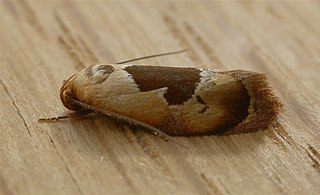
Hoplomorpha camelaea is a moth in the family Oecophoridae first described by Edward Meyrick in 1888. It is found in Australia, where it has been recorded from Victoria, Queensland, New South Wales and the Australian Capital Territory.

Lichenaula lichenea is a species of moth of the family Xyloryctidae. It is known in Australia from the Australian Capital Territory, New South Wales and Queensland.

Lichenaula calligrapha is a species of moth of the family Xyloryctidae. It is known from rainforests from northern Queensland to Victoria, although it has also been recorded from the Australian Capital Territory, New South Wales and Tasmania.
Catacometes hemiscia is a moth in the family Oecophoridae. It was described by Edward Meyrick in 1883. It is found in Australia, where it has been recorded from New South Wales.
Zelosyne olga is a moth in the family Gelechiidae. It was described by Edward Meyrick in 1915. It is found in Guyana.
Battaristis coniosema is a moth of the family Gelechiidae. It was described by Edward Meyrick in 1922. It is found in Peru and Pará, Brazil.
Antaeotricha sparganota is a moth of the family Depressariidae first described by Edward Meyrick in 1915. It is found in Guyana.
Catoryctis eugramma is a moth in the family Xyloryctidae. It was described by Edward Meyrick in 1890. It is found in Australia, where it has been recorded from New South Wales and Queensland.
Catoryctis tricrena is a moth in the family Xyloryctidae. It was described by Edward Meyrick in 1890. It is found in Australia, where it has been recorded from South Australia, Victoria and Western Australia.
Clerarcha dryinopa is a moth in the family Xyloryctidae. It was described by Edward Meyrick in 1890. It is found in Australia, where it has been recorded from the Australian Capital Territory, New South Wales and Victoria.
Lichenaula choriodes is a moth in the family Xyloryctidae. It was described by Edward Meyrick in 1890. It is found in Australia, where it has been recorded from New South Wales and Queensland.
Lichenaula lithina is a moth in the family Xyloryctidae. It was described by Edward Meyrick in 1890. It is found in Australia, where it has been recorded from New South Wales.
Lichenaula musica is a moth in the family Xyloryctidae. It was described by Edward Meyrick in 1890. It is found in Australia, where it has been recorded from South Australia, Victoria and Western Australia.
Lichenaula undulatella is a moth in the family Xyloryctidae. It was described by Francis Walker in 1864. It is found in Australia, where it has been recorded from New South Wales, Queensland and Western Australia.
Lichenaula selenophora is a moth in the family Xyloryctidae. It was described by Oswald Bertram Lower in 1892. It is found in Australia, where it has been recorded from New South Wales and Queensland.
Xylorycta ophiogramma is a moth in the family Xyloryctidae. It was described by Edward Meyrick in 1890. It is found in Australia, where it has been recorded from Queensland.
Eclecta is a monotypic moth genus in the family Depressariidae. Its only species, Eclecta aurorella, has been found in the Australian state of New South Wales. Both the genus and species were first described by Edward Meyrick in 1883.
Gonionota comastis is a moth in the family Depressariidae. It was described by Edward Meyrick in 1909. It is found in Peru and Colombia.

Agriophara confertella is a moth in the family Depressariidae. It was described by Francis Walker in 1864. It is found in Australia, where it has been recorded from Queensland, New South Wales and the Australian Capital Territory.
Antaeotricha glycerostoma is a moth in the family Depressariidae. It was described by Edward Meyrick in 1915. It is found in Colombia.



